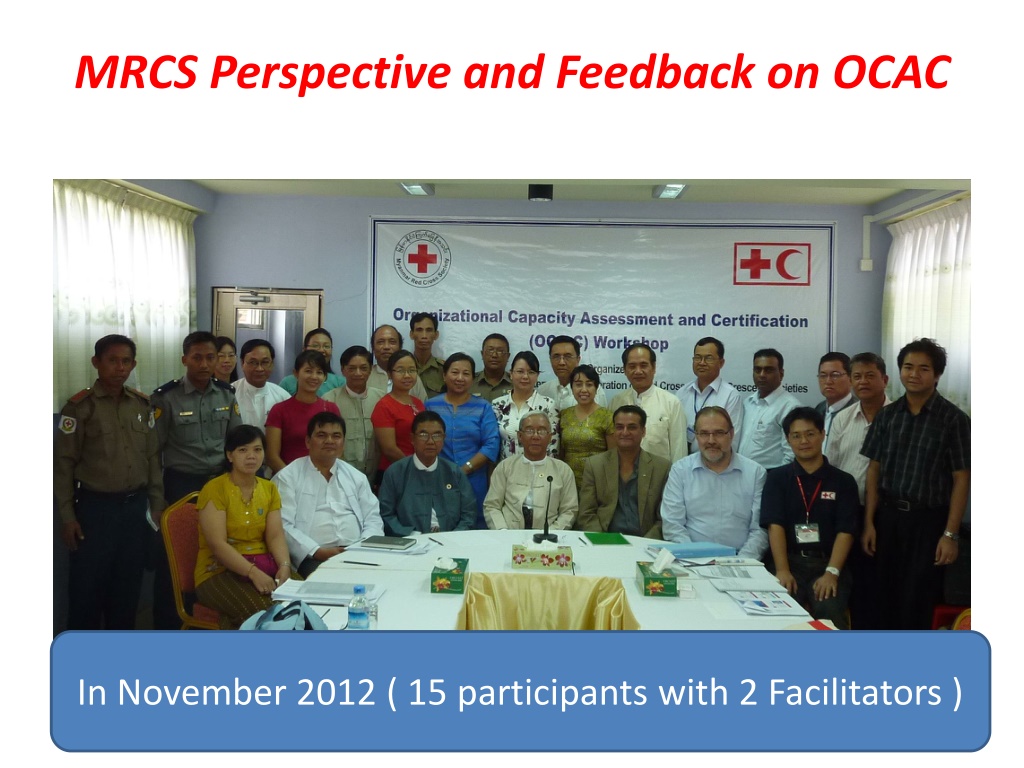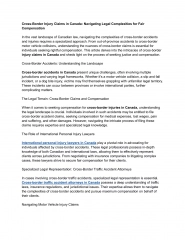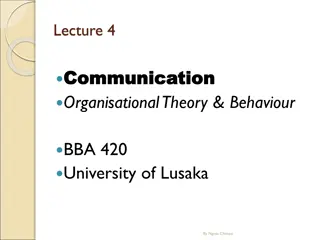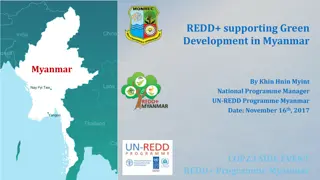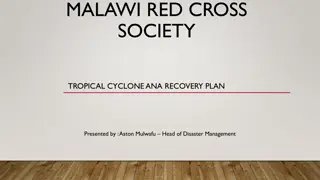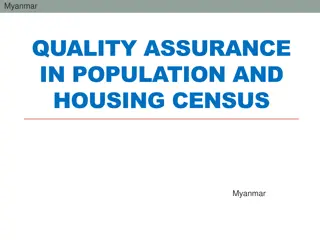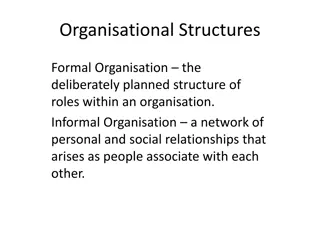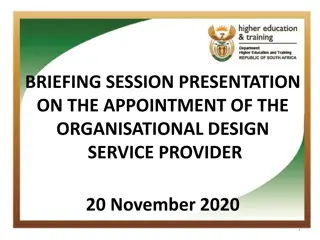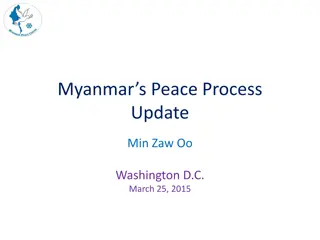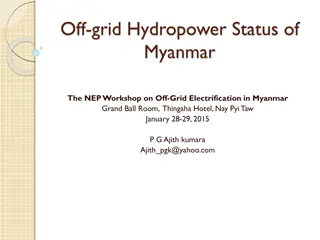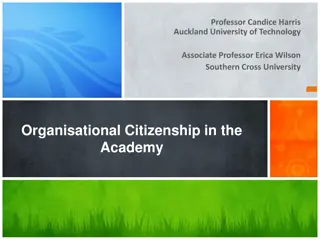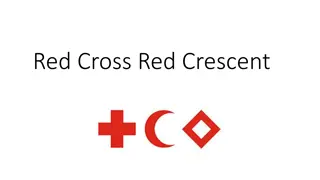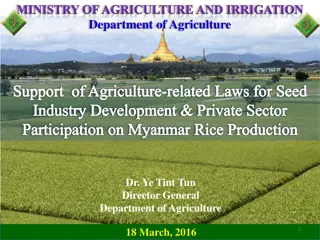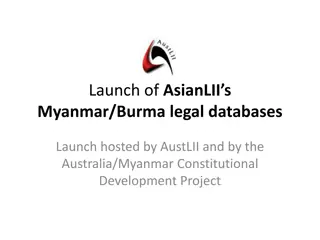Insights on Organisational Capacity Assessment for Myanmar Red Cross Society
In November 2012, a session was conducted with 15 participants and 2 facilitators to assess the Organisational Capacity of the Myanmar Red Cross Society (MRCS). The session aimed to evaluate critical conditions for sustained performance, measure core capacities and attributes, and prioritize actions based on the results. The outcomes were used to identify capacity deficits, plan development strategies, and prioritize urgent actions essential for MRCS's growth and improvement.
Download Presentation

Please find below an Image/Link to download the presentation.
The content on the website is provided AS IS for your information and personal use only. It may not be sold, licensed, or shared on other websites without obtaining consent from the author. Download presentation by click this link. If you encounter any issues during the download, it is possible that the publisher has removed the file from their server.
E N D
Presentation Transcript
MRCS Perspective and Feedback on OCAC In November 2012 ( 15 participants with 2 Facilitators )
Objectives of OCAC Internal self assessment Organisational Capacity Assessment to assess ourselves against defined international standards to develop and implement a tailor-made development Plan Certification by the IFRC Governing Board
Critical conditions - looked into for sustained performance Capacity to exist Capacity to organize Capacity to relate and to mobilize Capacity to perform Capacity to grow
Phase I - How did we measure? Indicators Attributes Core capacities A B C D E Strategic Plan A - E 1 - 4 A B C D E The NS has Statutes that are available at all levels of the NS. The Statutes have been revised less than 10 years ago. The NS Statutes meet the requirements of the guidance document. The NS regularly discusses and disseminates its Statutes. It involves all levels of the NS in this process.
According to 5 core capacity areas, 63 Attributes positioning in A and B score, were needed to tackle urgently. Myanmar Red Cross Society OCA-C Internal Assessment 2012 - Grading results 34 35 29 30 25 18 20 No; of Attributes 15 10 7 4 5 0 A B C D E
How did we use OCAC results? 1. Identified What are the critical capacity deficits of MRCS? 2. prioritized actions for MRCS s Development Plan. 3. Planned How MRCS should do to fulfil these deficits 1. 2013 Development plan 2. 2014-2015 Development plan
Phase I - How did we prioritize ? Core capacities Attributes Indicators Prioritize 1 - 4 A-E A B C D E A or B A: The NS has no statistics related to volunteer involvement PRIORITIZE 1- Not relevant 2 Relevant but not Urgent 3 Relevant and Urgent 4 Critical ( Law revise, Emblem, state/region /branch capacity build)
Pie chart diagram showed that MRCS has only 4.35% of attributions represented highest and great satisfied level Vs 31.52% of attributions are worst level needed to be improved or urgent needed to be changed in organizational development process. 4.35% 7.61% 31.52% 19.57% Grade-A Grade-B Grade-C Grade-D Grade-E 36.96%
Priorities according to OCAC findings; 1. Institutional matters (highest) 2. Legal tools (highest) 3. Security and safety awareness (highest)- 4. Resource mobilization (highest)- 5. Identity (2nd) 6. Protection of image and reputation (2nd) 7. Communication (2nd) 8. Learning from others (3rd)
Planned How MRCS should do to fulfil these deficits Developed - 1. 2013 Development plan 2. 2014-2015 Development plan
based on 63 Attributes positioning in A and B, 42 actions were planned to tackle in urgent in 2013, 19 actions have been done at the end of 2013 (45%)
MRCSs Development Plan For 2014-2015 23 Actions are needed to address in 2014-2015 (55%)
Institutional matters and Legal tools 2013 2014-2015 1. Scaling up Community based programmes 2. Selection of pilot branches and coverage of community based Program in country in line with OD recommendation 3. Regular review and update of Branch development model 4. clear boundary between governance and management. 5. Improve communication & Information capacity and system 6. Statutes revision 7. Develop Emblem law within one year after approved new Law. 8. Establish common PMER system at all levels. 1. Scaling up Community based programmes Selection of pilot branches and coverage of community based Program in country in line with OD recommendation 2. 3. Develop clear roles of senior management level development of Communication Policy Law and statutes revision Waiting for approved new Law. 4. 5. 6.
Security and safety awareness 2013 2014-2015 1. Developed and followed code of conduct . 1. Develop and operate Staff and Volunteer safety and security guideline and provide related supports 2. Continue Volunteer insurance and practice. Awareness on internal reporting system regarding violence/abuse of power for staff and volunteers 2. Continue Volunteer insurance and practice. 3. Provide basic security training for staff and safer access session to all staff/RCVs with effective monitoring system. 4. Develop internal reporting system regarding violence/abuse of power for staff and volunteers 5. Undertake humanitarian diplomacy to support vulnerable people in Myanmar. 3. 4. Undertake humanitarian diplomacy to support vulnerable people in Myanmar.
Resource mobilization 2013 2014-2015 1. Developed HR policy and regulation, Child Protection Policy, staff- orientation/Induction Info; booklet.etc. 1. Development and initiate CAS strategy 2. Develop Membership policies and regulation. 3. implement the approved cost recovery model 4. Recruit at least one paid staff per state/region under core structure. 2. Determined core structure and core budget covering to 30% or less of total budget. Initiated Development of core service policy 3. 5. Support to have RC branch office at 40% of branches by the end of 2015. 4. Support to have RC branch office at 40% of branches by the end of 2015. Volunteer mobilization at IDP camps/remote areas ( deployment of RCVs, invest capacity building trainings and recovery operation) 6. Volunteer mobilization at IDP camps/remote areas ( deployment of RCVs, invest capacity building trainings and recovery operation) 5.
Resource mobilization 2013 2014-2015 6. Upgrade current Finance management system at all levels(Navision software + trainings) Standard reporting template and information tool.(Finance, branch level) Up grade RM unit to RM division to develop RM strategy and identify target group of fundraising activities. Market MRCS First Aid and Safety services trainings to commercial customers. 7. Upgrade current Finance management system at all levels 8. Start Resource Management System and assign volunteer data base focal person in Nhq. 7. 8. 9. Market MRCS First Aid and Safety services trainings to commercial customers. 9. 10. Strengthens RC youth development Programme to support MRCS community based programme.
Follow up Actions in 2013-2014 OCAC-report , after assessment 1. Shared OCAC report to all movement partners, Central council members, and management staff Reviewed and revised MRCS s Strategic Plan 2015 regarding to OCAC deficits and shared revised SP 2015 to all PNSs Priority Core Areas and actions and POA. Disseminated Priority Core Areas and actions to PNS meeting in Oct 2013. Developed 2014-2015 Operational Plans in line with OCAC report and revised SP -2015 2. 3. 4. 5.
Benefits of O-CAC process 1. 4 E outstanding efforts ->> inspire mark for MRCS 2. 63- Deficits- >> Opportunity for MRCS s tailor-made Development Plan 3. Common understanding >>>Where MRCS is and what we have done and what we need to tackle in urgent. 4. pledge and committed << Governance and Management level 5. Transparency Partners- >> building trust 6. >>increased # of Donor 7. interest and support of Donor particular areas 8. Self confidence - All Departments/Unit- in development of yearly operational plan
Challenges Long term support ( more than 3 year) support of Union of Government Workload of Senior Management staffs higher turn over rate
Lesson learned and need support from Donors 1. Continuous OCAC assessment annually. 2. Next Strategic Plan 2016-2020 should be in line with the deficits of OCAC assessment and Indicators/attributes. 3. Both short-term and Long term Development plan 4. legal base development and dissemination to all staff, members and the public must be regular and continuous. 5. Humanitarian Diplomacy is very impartant 6. Annual progress reports should be made with the help of PMER support. 7. CAS strategy is needed to support OCAC based implementation plans. 8. Any NS should do the OCAC Internal assessment.
